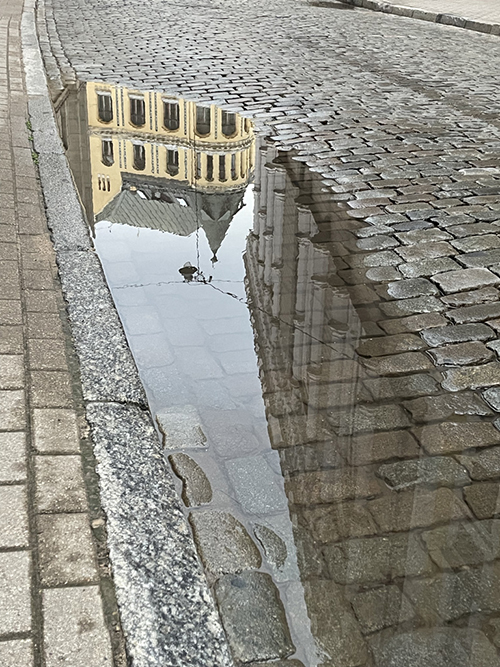COURSE DESCRIPTION FOR THE AY 2023-24

“All five human senses are involved with a book. We pick up a book and our fingertips feel the material of the binding and the texture of the paper. Our gaze slides over the lines of the text, stopping at illustrations and details of pictures. Our nose lets us smell the scent of a book fresh out of a printer’s shop or guess what kind of aromas of yesteryear have saturated the pages of an old book.
In childhood, the contents of the book first became known to us through hearing, listening to someone reading to us. Later, reading aloud or turning a score to music, we have given voice to the book. The very first book we got to hold we probable tried to taste. Later, we may have looked for a book to make or experience something new and unknown. Hands, eyes, nose, tongues: at the moment of reading, it is not only our mind and emotions but also our body that meets the books.”
Excerpt from the Latvia permanent exhibition Book in Latvia
The National Library of Latvia in Riga
The above excerpt is perhaps a metaphor for the work of an architect and, I believe, the importance of creating a long-lasting memory through space.
Between dream and reality, an aesthetic experience of daily life…
The ambition of the design studio will focus on a series of open-ended questions surrounding the “design of space” and “the setting in space of ideas” within the discipline of architecture. As both individuals and as a collective group, we will explore how ideas, concepts, and themes can help conceive architectural spaces and places. Most importantly we will focus on how to give them physicality, which has been one of the most important ways to legitimize our role as leaders within the built environment.
During these two semesters, we will embark on studying the discipline of architecture as a process that involves an acute sense of creativity both at the intuitive and rational levels of design. Hence, the education of an architect will be framed as part of a larger series of questions surrounding concepts pertaining to the body of history and theory, abstract and real context, structure and construction, art and urbanism from which key design strategies can be extracted, understood and redirected toward the creation of your own work.
Your second-year design experience constitutes the basis for introducing the fundamentals of architecture, a journey that will balance tradition and innovation, theory and pragmatics, design and construction. A number of suggested design projects and punctual charrettes will test your creative energy.
Fall 2023: tentative projects
- How do you see and express yourself? The drawing of space
- How do you see and understand? Measuring and drawing to learn the basic system of notations
- How to you see and interpret? Series of punctual charettes
- How do you see and design? the cemetary project (design) which incorporates all above topics.
Spring 2024: tentative project
1. How do you see the past and present? an urban loft renovation (urban design);
Charette interludes
Both projects will span an entire semester with a series of charettes and punctual tasks. For the Fall, students will design a number of spaces and places in Christiansburg. The various program briefs will be revealed incrementally as each builds upon the past interventions. The spring semester projects will center on an urban loft project.
The broader intention of this lab is not only to fulfill a series of curricular requirements but most importantly to pursue an architecture in search of poetry and spatial delight. Past second year visual archives are to be found under: Academic year 2019-2020; Academic year 2020-2021; and Academic year 2021-2022;
Student learning outcomes
By the end of the academic year, students will have acquired the following:
- Awareness of the potential of an architecture in search of poetry, differentiating building from architecture;
- Understanding what constitutes an idea, a concept, a partie, and a design strategy;
- Ability to distinguish between what appears to be real and its representation, what is essential and what is exceptional;
- Ability to attribute to a project a clear set of theoretical premises and defined strategies;
- Understanding the filiation of the five basics 20th century spatial configurations of architecture,
- And an appreciation that research leads to the coherence and authenticity of any design project –YOUR project in particular.
I invite students interested in this pedagogy to read select blogs of your interest. Many of them were created in response to the past years student cohorts and feature fundamental design themes, often accompanied by work conducted directly in the studio context by my students: https://atelierdehahn.com/blog/
Materials to purchase for this year’s design studio

Please click to view the requested materials that will need to be purchased for the second day of class.
Conclusion
I very much look forward introducing you to a complex world of architecture, one that is nothing less than fascinating, ambitious and visionary. You can change and will be called in contributing to our future, one that is full of promises. To achieve your goals, you will need to be creative, innovative, persistent, open-minded, and above all hard working and diligent in your endeavors. Those are major components to become a extremely successful student during your tenure with us at VT.
Note
I have selected a number of blogs that I ask you to read prior to our meeting this Monday. They highlight process and pedagogy offered in any of my second year design studios.
Architecture Education: Some thoughts on teaching. Part 2
Architectural Education: Some thoughts on teaching. Part 1
Architectural Education: First steps in a student’s design process
Architectural Education: the nature of being-Shaker architecture, Rainer Marie Rilke, and Louis I Kahn
Important links
At the end of the year, students will be able to design and present visually and orally a complex architectural project as demonstrated by previous design studios.